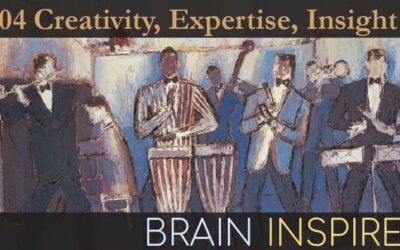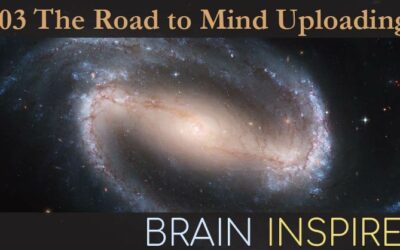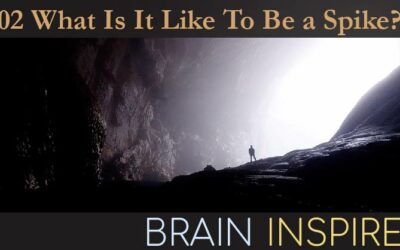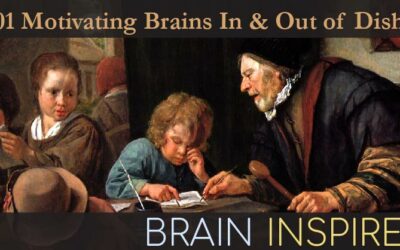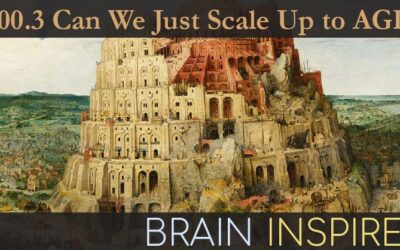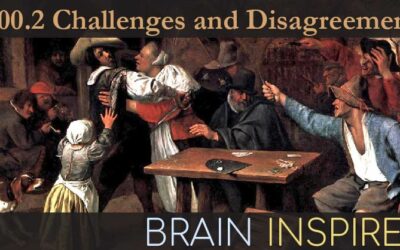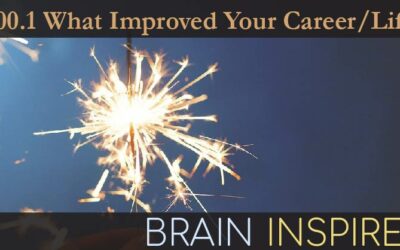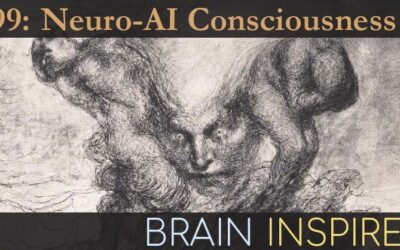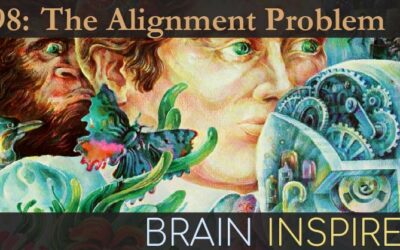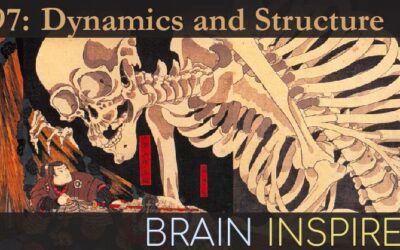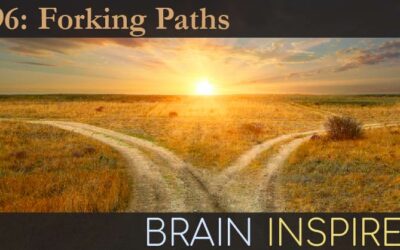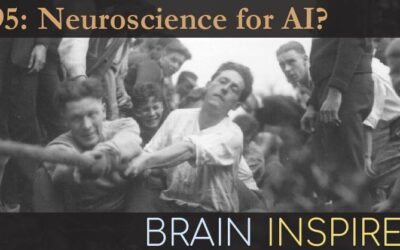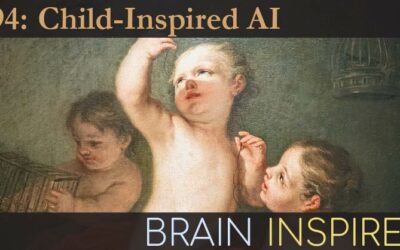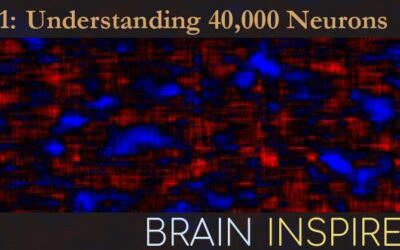All Episodes
BI 104 John Kounios and David Rosen: Creativity, Expertise, Insight

What is creativity? How do we measure it? How do our brains implement it, and how might AI?Those are some of the questions John, David, and I discuss. The neuroscience of creativity is young, in its “wild west” days still. We talk about a few creativity studies they’ve performed that distinguish different creative processes with respect to different levels of expertise (in this case, in jazz improvisation), and the underlying brain circuits and activity, including using transcranial direct current stimulation to alter the creative process. Related to creativity, we also discuss the phenomenon and neuroscience of insight (the topic of John’s book, The Eureka Factor), unconscious automatic type 1 processes versus conscious deliberate type 2 processes, states of flow, creative process versus creative products, and a lot more.
BI 103 Randal Koene and Ken Hayworth: The Road to Mind Uploading

Randal, Ken, and I discuss a host of topics around the future goal of uploading our minds into non-brain systems, to continue our mental lives and expand our range of experiences. The basic requirement for such a subtrate-independent mind is to implement whole brain emulation. We discuss two basic approaches to whole brain emulation. The “scan and copy” approach proposes we somehow scan the entire structure of our brains (at whatever scale is necessary) and store that scan until some future date when we have figured out how to us that information to build a substrate that can house your mind. The “gradual replacement” approach proposes we slowly replace parts of the brain with functioning alternative machines, eventually replacing the entire brain with non-biological material and yet retaining a functioning mind.
Randal and Ken are neuroscientists who understand the magnitude and challenges of a massive project like mind uploading, who also understand what we can do right now, with current technology, to advance toward that lofty goal, and who are thoughtful about what steps we need to take to enable further advancements
BI 102 Mark Humphries: What Is It Like To Be A Spike?

Mark and I discuss his book, The Spike: An Epic Journey Through the Brain in 2.1 Seconds. It chronicles how a series of action potentials fire through the brain in a couple seconds of someone’s life. Starting with light hitting the retina as a person looks at a cookie, Mark describes how that light gets translated into spikes, how those spikes get processed in our visual system and eventually transform into motor commands to grab that cookie. Along the way, he describes some of the big ideas throughout the history of studying brains (like the mechanisms to explain how neurons seem to fire so randomly), the big mysteries we currently face (like why do so many neurons do so little?), and some of the main theories to explain those mysteries (we’re prediction machines!). A fun read and discussion.
BI 101 Steve Potter: Motivating Brains In and Out of Dishes

Steve and I discuss his book, How to Motivate Your Students to Love Learning, which is both a memoir and a guide for teachers and students to optimize the learning experience for intrinsic motivation. Steve taught neuroscience and engineering courses while running his own lab studying the activity of live cultured neural populations (which we discuss at length in his previous episode). He relentlessly tested and tweaked his teaching methods, including constant feedback from the students, to optimize their learning experiences. He settled on real-world, project-based learning approaches, like writing wikipedia articles and helping groups of students design and carry out their own experiments. We discuss that, plus the science behind learning, principles important for motivating students and maintaining that motivation, and many of the other valuable insights he shares in the book.
BI 100.6 Special: Do We Have the Right Vocabulary and Concepts?

We made it to the last bit of our 100th episode celebration. These have been super fun for me, and I hope you’ve enjoyed the collections as well. If you’re wondering where the missing 5th part is, I reserved it for Brain Inspired’s magnificent Patreon supporters (thanks guys!!!!). The final question I sent to previous guests:
Do we already have the right vocabulary and concepts to explain how brains and minds are related? Why or why not?
BI 100.4 Special: What Ideas Are Holding Us Back?

In the 4th installment of our 100th episode celebration, previous guests responded to the question:
What ideas, assumptions, or terms do you think is holding back neuroscience/AI, and why?
As per usual, the responses are varied and wonderful!
BI 100.3 Special: Can We Scale Up to AGI with Current Tech?

Part 3 in our 100th episode celebration. Previous guests answered the question:
Given the continual surprising progress in AI powered by scaling up parameters and using more compute, while using fairly generic architectures (eg. GPT-3), do you think the current trend of scaling compute can lead to human level AGI? If not, what’s missing?
It likely won’t surprise you that the vast majority answer “No.” It also likely won’t surprise you, there is differing opinion on what’s missing.
BI 100.2 Special: What Are the Biggest Challenges and Disagreements?

In this 2nd special 100th episode installment, many previous guests answer the question: What is currently the most important disagreement or challenge in neuroscience and/or AI, and what do you think the right answer or direction is? The variety of answers is itself revealing, and shows how many interesting problems there are to work on.
BI 100.1 Special: What Has Improved Your Career or Well-being?

Brain Inspired turns 100 (episodes) today! To celebrate, my patreon supporters helped me create a list of questions to ask my previous guests, many of whom contributed by answering any or all of the questions. I’ve collected all their responses into separate little episodes, one for each question. Starting with a light-hearted (but quite valuable) one, this episode has responses to the question, “In the last five years, what new belief, behavior, or habit has most improved your career or well being?” See below for links to each previous guest. And away we go…
BI 099 Hakwan Lau and Steve Fleming: Neuro-AI Consciousness

Hakwan, Steve, and I discuss many issues around the scientific study of consciousness. Steve and Hakwan focus on higher order theories (HOTs) of consciousness, related to metacognition. So we discuss HOTs in particular and their relation to other approaches/theories, the idea of approaching consciousness as a computational problem to be tackled with computational modeling, we talk about the cultural, social, and career aspects of choosing to study something as elusive and controversial as consciousness, we talk about two of the models they’re working on now to account for various properties of conscious experience, and, of course, the prospects of consciousness in AI. For more on metacognition and awareness, check out episode 73 with Megan Peters.
BI 098 Brian Christian: The Alignment Problem

Brian and I discuss a range of topics related to his latest book, The Alignment Problem: Machine Learning and Human Values. The alignment problem asks how we can build AI that does what we want it to do, as opposed to building AI that will compromise our own values by accomplishing tasks that may be harmful or dangerous to us. Using some of the stories Brain relates in the book, we talk about:
BI 097 Omri Barak and David Sussillo: Dynamics and Structure

Omri, David and I discuss using recurrent neural network models (RNNs) to understand brains and brain function. Omri and David both use dynamical systems theory (DST) to describe how RNNs solve tasks, and to compare the dynamical stucture/landscape/skeleton of RNNs with real neural population recordings. We talk about how their thoughts have evolved since their 2103 Opening the Black Box paper, which began these lines of research and thinking.
BI 096 Keisuke Fukuda and Josh Cosman: Forking Paths

K, Josh, and I were postdocs together in Jeff Schall’s and Geoff Woodman’s labs. K and Josh had backgrounds in psychology and were getting their first experience with neurophysiology, recording single neuron activity in awake behaving primates. This episode is a discussion surrounding their reflections and perspectives on neuroscience and psychology, given their backgrounds and experience (we reference episode 84 with György Buzsáki and David Poeppel). We also talk about their divergent paths – K stayed in academia and runs an EEG lab studying human decision-making and memory, and Josh left academia and has worked for three different pharmaceutical and tech companies. So this episode doesn’t get into gritty science questions, but is a light discussion about the state of neuroscience, psychology, and AI, and reflections on academia and industry, life in lab, and plenty more.
BI 095 Chris Summerfield and Sam Gershman: Neuro for AI?

It’s generally agreed machine learning and AI provide neuroscience with tools for analysis and theoretical principles to test in brains, but there is less agreement about what neuroscience can provide AI. Should computer scientists and engineers care about how brains compute, or will it just slow them down, for example? Chris, Sam, and I discuss how neuroscience might contribute to AI moving forward, considering the past and present. This discussion also leads into related topics, like the role of prediction versus understanding, explainable AI, value alignment, the fundamental conundrum that humans specify the ultimate values of the tasks AI will solve, and more. Plus, a question from previous guest Andrew Saxe.
BI 094 Alison Gopnik: Child-Inspired AI

Alison and I discuss her work to accelerate learning and thus improve AI by studying how children learn, as Alan Turing suggested in his famous 1950 paper. The ways children learn are via imitation, by learning abstract causal models, and active learning by implementing a high exploration/exploitation ratio. We also discuss child consciousness, psychedelics, the concept of life history, and lots more.
BI 093 Dileep George: Inference in Brain Microcircuits

Dileep and I discuss his theoretical account of how the thalamus and cortex work together to implement visual inference. We talked previously about his Recursive Cortical Network (RCN) approach to visual inference, which is a probabilistic graph model that can solve hard problems like CAPTCHAs, and more recently we talked about using his RCNs with cloned units to account for cognitive maps related to the hippocampus. On this episode, we walk through how RCNs can map onto thalamo-cortical circuits so a given cortical column can signal whether it believes some concept or feature is present in the world, based on bottom-up incoming sensory evidence, top-down attention, and lateral related features. We also briefly compare this bio-RCN version with Randy O’Reilly’s Deep Predictive Learning account of thalamo-cortical circuitry.
BI 092 Russ Poldrack: Cognitive Ontologies

Russ and I discuss cognitive ontologies – the “parts” of the mind and their relations – as an ongoing dilemma of how to map onto each other what we know about brains and what we know about minds. We talk about whether we have the right ontology now, how he uses both top-down and data-driven approaches to analyze and refine current ontologies, and how all this has affected his own thinking about minds. We also discuss some of the current meta-science issues and challenges in neuroscience and AI, and Russ answers guest questions from Kendrick Kay and David Poeppel.
BI 091 Carsen Stringer: Understanding 40,000 Neurons

Carsen and I discuss how she uses 2-photon calcium imaging data from over 10,000 neurons to understand the information processing of such large neural population activity. We talk about the tools she makes and uses to analyze the data, and the type of high-dimensional neural activity structure they found, which seems to allow efficient and robust information processing. We also talk about how these findings may help build better deep learning networks, and Carsen’s thoughts on how to improve the diversity, inclusivity, and equality in neuroscience research labs.
